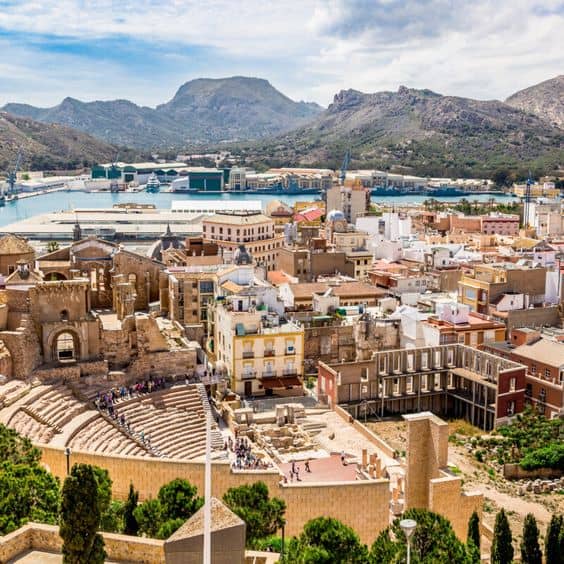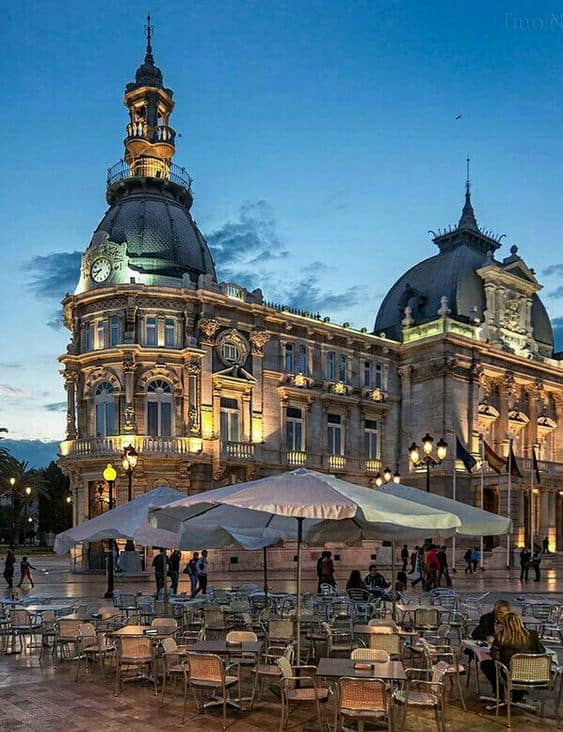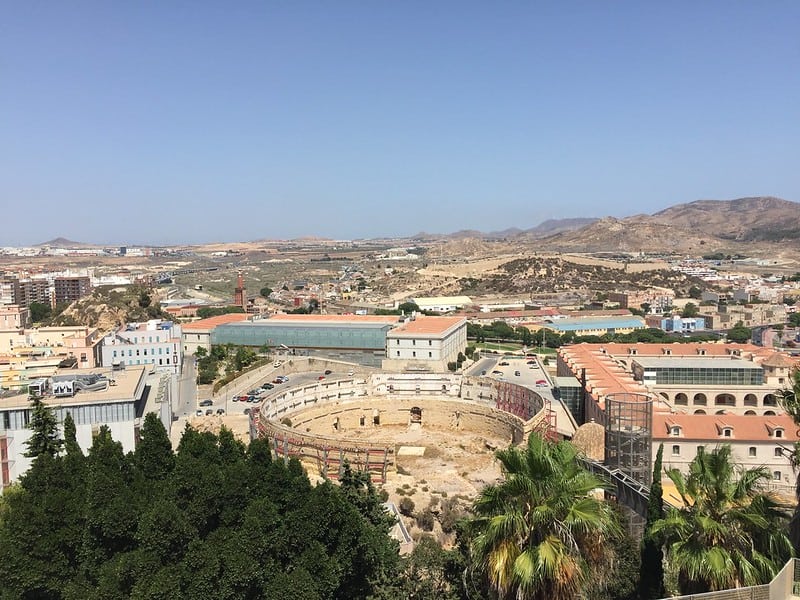You can visit the Cartagena Battery, built during the rule of Primo de Rivera, which is part of a series of batteries used to defend the coast of Cartagena. The fortified area contains tunnels and medieval-style turrets that blend in with the mountainside. Cartagena has been a major military centre for hundreds of years, and the city is still home to Spanish army units.
History of Cartagena Spain
Cartagena, located in the southeastern region of Spain, is a city with a history that dates back over two millennia. From its humble beginnings as a strategic Carthaginian settlement to its modern-day prominence as a bustling port city, Cartagena’s journey through time is a captivating tale of conquests, cultural influences, and maritime significance. Let’s embark on a historical voyage through Cartagena’s past with a timeline of significant events.
3rd Century BC – Carthaginian Settlement:
- 227 BC: Cartagena was founded by the Carthaginians under the leadership of Hasdrubal the Fair, brother-in-law of the famous Carthaginian general, Hannibal. It was established as a strategic naval base and trading centre, known as “Carthago Nova.”
2nd Century BC – Roman Domination:
- 209 BC: During the Second Punic War, the Romans captured Cartagena from the Carthaginians and subsequently named it “Carthago Spartaria.” It became a prosperous Roman colony and an essential center for mining and commerce.
5th – 8th Century AD – Visigothic and Byzantine Rule:
- 5th Century: After the fall of the Roman Empire, Cartagena came under Visigothic rule.
- 6th – 8th Century: The city experienced brief Byzantine rule during the Byzantine Reconquest.
13th – 14th Century – Reconquista and Christian Rule:
- 1245: Cartagena was reconquered by the Crown of Castile under King Alfonso X, marking the end of Muslim rule in the region.
- 1296: King James II of Aragon granted Cartagena the title of “Very Noble and Very Loyal,” acknowledging its loyalty during the conquest.
16th – 18th Century – Golden Age of Trade and Naval Power:
- 16th Century: Cartagena flourished during the Spanish Golden Age of trade and exploration, becoming a major naval base for the Spanish Armada.
- 18th Century: The city witnessed significant urban development and fortification, constructing defensive structures such as the Castillo de la Concepción and the impressive city walls.
19th – 20th Century – Industrialization and Modernization:
- 1810: Cartagena played a significant role during the Napoleonic Wars, resisting the French occupation.
- 19th Century: The city experienced industrial growth, with the establishment of shipyards, mining, and modernization of its port facilities.
- 1937: During the Spanish Civil War, Cartagena remained a Republican stronghold.
21st Century – Cultural Revival and Maritime Significance:
- 2008: Cartagena was designated as a UNESCO World Heritage Site for its rich archaeological and historical significance.
- Today: Cartagena stands as a bustling port city, preserving its historical heritage while embracing its role as a cultural and economic hub.
Cartagena’s illustrious history, influenced by Carthaginian, Roman, Visigothic, and Christian civilizations, has left an indelible mark on its architectural and cultural landscape. Today, visitors to Cartagena can immerse themselves in the city’s vibrant history, explore its well-preserved Roman ruins, and experience its vibrant maritime ambiance, ensuring a captivating journey through time in this ancient port city of Spain.
Museo Foro Romano Molinete
The Museo Foro Romano Molinetede is a sheltered archaeological site that houses excavated Roman forum remains. This site is worth a visit if you’re in Cartagena. You can explore the excavated ruins and learn more about the history of Cartagena.
This is one of the most impressive and interesting buildings in Cartagena. You can get to know about the Romans here and see the theater that was built in 164 BC. The museum is well-designed and concludes inside the ancient theater. Also, be sure to visit the Arqua, the National Museum of Underwater Archeology. The Arqua is open Tuesday-Saturday from 10am to 8pm and Sundays and national holidays.
Another fascinating part of the museum is the virtual reality experience. Visitors can use a tablet to walk through the neighbourhood of the Roman Forum. It gives them a 360-degree view of buildings and a taste of life in Roman times. It costs around five euros to use this experience.

Museo Del Teatro Romano
The Museo Del Teatro Romano in the city of Cartagena, Spain, is a fascinating museum designed by architect Rafael Moneo. The complex is located on the plaza del Ayuntamiento and connects to a restored Roman theatre that dates back to the first century BC. The museum is divided into two separate buildings and has permanent and temporary exhibitions. There are also tours of the city and its ancient history that will enlighten and delight visitors to the region.
The ruins of the ancient Roman theatre were discovered during the demolition of nearby buildings. The main goal of the museum is to integrate this lost theater into the city’s past and present. The museum’s main entrance is on the Town Hall Square, and the museum’s administrative and service rooms are located in the late 19th century Riquelme Palace. From there, an escalator takes visitors to the upper levels of the museum.
The museum houses artifacts found during excavations of the Roman Theater. There is also an aerial photo exhibit that gives visitors an idea of the size of the theater. The Museum also offers a chance to see the theater’s mural.

Bateria de Castillitos
If you are looking for an eye-catching complex in Cartagena, Spain, you should visit the Bateria de Castillitos. The castle is located at an elevation of 250 meters and was constructed in a modernist, eclectic and historicist style. The architecture mimics the rock texture of the surrounding mountainous terrain. The castle’s aljibe, or cliff-side location, is also reminiscent of a castle.
The Bateria de Castillitos was built in the 1930s to defend Cartagena. It was constructed to prevent enemy ships from entering the bay and protect the city’s military arsenal. The impressive defense system is set on a cape overlooking the sea and is the perfect location to watch for pirates or armed attacks.
You can get to the Bateria de Castillitos from La Azoha by driving up the Campillo de Adentro, a hillside road that climbs about 8 kilometers. While the journey is steep, it offers spectacular views of the coastline. From the top, you can enjoy the view of the sea and the surrounding mountains.
Playa de Calblanque
If you’re a beach lover, you’ll want to spend a few days in Playa de Calblanque. This pristine stretch of coastline is protected by a natural park and is home to some of the best natural beaches in Murcia. The region also has a rich and varied wildlife, including rare plants and animals. It’s a wonderful spot to spend your days sunbathing on the white sands or taking a walk in the greenery.
The beaches in Calblanque are sandy and very wide. The area does not have many facilities, but it does offer free parking and a lifeguard during the summer months. There are several different beaches here, including the south beach, which is the most popular. You can wear less clothing on these beaches than you would in the rest of Cartagena.

Calle Mayor
Calle Mayor is the main pedestrian street of Cartagena and is a great place to sightsee, browse, and enjoy the evening atmosphere. You’ll also be able to admire the town’s beautiful Modernist architecture. The town was once a center of a booming mining industry, and the remnants of that prosperity can be seen today. Several buildings in the historic center were reconstructed in a modernist style. Some examples of these buildings include the Casino de Cartagena, the Palacio de Aguirre, and the Casa Cervantes.
During the Roman period, the city was a major silver mine, with daily revenues of 25,000 drachmas. In addition, the city was known for the production of esparto grass and fermented fish sauce. These two commodities earned the city its new name, Cartago Spartaria. The city was also home to a French naval force during the Seven Years’ War. After the British defeated the French naval force at sea, the French fleet took shelter in the city’s port.
Experiencia 43
If you love liqueurs and the history behind their production, you can’t miss the 43 Experience Tour in Cartagena. This tour takes about an hour and a half and costs ten Euros. It walks guests through the history of the liqueur and its production, from the start in the Cartagena refinery to its current location. Along the way, you can also tour the assembling plant.
The museum features a video that shows the process of making the liquor, along with numerous exhibits and a chill-out bar. The museum also includes memorabilia, including all different versions of the bottles. The museum also contains promotional items. Visitors can buy bottles of the famous liquor, which is extremely popular in Europe.
The experience is 2 hours long and includes a tour of the factory, bottling line, museum, and tastings. Visitors can also purchase a gift pack of the popular liqueur.
Museo Naval
Located near Cartagena, Spain, the Museo Naval in Cartagena Spain presents exhibitions on maritime construction. The museum is a branch of the Spanish Naval Museum in Madrid. Its exhibits showcase the rich history and development of Spanish naval shipbuilding. The museum is open to the public free of charge.
The museum’s collection contains more than three thousand items, which are arranged in thematic areas. Special exhibits include the Peral Submarine, which was transferred from the seafront to the museum in 2013. The submarine is housed in a special room that showcases its history and audiovisual media. This exhibit highlights the valuable legacy left by Cartagena sailor Isaac Peral, a native of the city.
The Cartagena Naval Museum is a must-see when visiting the city. Its displays are organized according to theme areas, making it a great place to learn about the city’s naval history. It also includes a replica of the 18th-century pirate ship, which stretches nearly to the ceiling of a large hall.
Museo Historico Militar de Cartagena
The Museo Histórico Militar de Cartagena, located in the city of Cartagena, Spain, is dedicated to the history of the Spanish Army. It features a museum featuring various weapons, uniforms, and more. Located near the seafront, this museum is a must-see for military history enthusiasts.
The museum was inaugurated on June 11, 1997. It is part of the Museo Militar Regional de Seville and is spread out across several rooms and two floors. It covers the history of various arms of the Spanish Army, but focuses on artillery weapons. There are many models, dioramas, and informative panels in Spanish and English.
The Museum was built on a rectangular site with an area of 17,302 square meters. The original building is divided into two bodies: the first body houses the Municipal Archive and the second serves as the Cartagena Museum.
10 interesting facts about Cartagena Spain
- Ancient Roots: Cartagena has a history dating back over 2,500 years, making it one of the oldest cities in Spain. It was founded by the Carthaginians in 227 BC.
- Punic Wars: The city’s name “Cartagena” is derived from “Carthago Nova,” which means “New Carthage.” It was a crucial Carthaginian naval base during the Punic Wars.
- Roman Influence: Cartagena became a prominent Roman colony during the Roman Empire and was known as “Carthago Spartaria.”
- Roman Theatre: One of Cartagena’s most impressive landmarks is the Roman Theatre, which dates back to the 1st century BC. It’s one of the best-preserved Roman theatres in Spain.
- Modernist Architecture: Cartagena is known for its beautiful modernist architecture, particularly seen in the Grand Hotel and Casino, designed by renowned architect Victor Beltri.
- Naval History: The city has a strong naval tradition and was an essential naval base for the Spanish Navy.
- Art and Culture: Cartagena is home to several museums and art galleries, including the ARQUA National Museum of Underwater Archaeology and the Cartagena Regional Museum of Modern Art.
- Holy Week Celebrations: Cartagena hosts one of the most spectacular Holy Week processions in Spain, with elaborate floats, religious sculptures, and traditional music.
- Submarine Archaeological Park: The Cartagena Bay is home to an extraordinary underwater archaeological park that preserves shipwrecks and ancient artifacts.
- Festivals and Carnivals: Cartagena celebrates various festivals throughout the year, including the Carthaginians and Romans Festival, which commemorates the city’s historical past.

